Identity, Transformations, and Societal Roles in The Yellow Wallpaper
VerifiedAdded on 2023/05/31
|10
|3008
|275
Essay
AI Summary
This essay explores the themes of identity and transformations in Charlotte Perkins Gilman's short story, "The Yellow Wallpaper." Published in 1892, the story draws upon Gilman's personal experiences with nervous prostration and the rest cure treatment, which involved isolation and a ban on intellectual activities. The narrative follows a woman's descent into madness as she becomes obsessed with the yellow wallpaper in her room, symbolizing the restrictive roles and male dominance prevalent in 19th-century American society. The essay discusses how the protagonist's confinement and lack of creative outlet lead to her psychological deterioration and eventual rebellion against the oppressive environment. It examines the story's feminist themes, highlighting the challenges faced by women in a male-dominated era and the destructive impact of societal expectations on their mental and emotional well-being. The analysis emphasizes the protagonist's struggle for freedom and self-expression, as well as the story's critique of medical practices that pathologized and confined women.
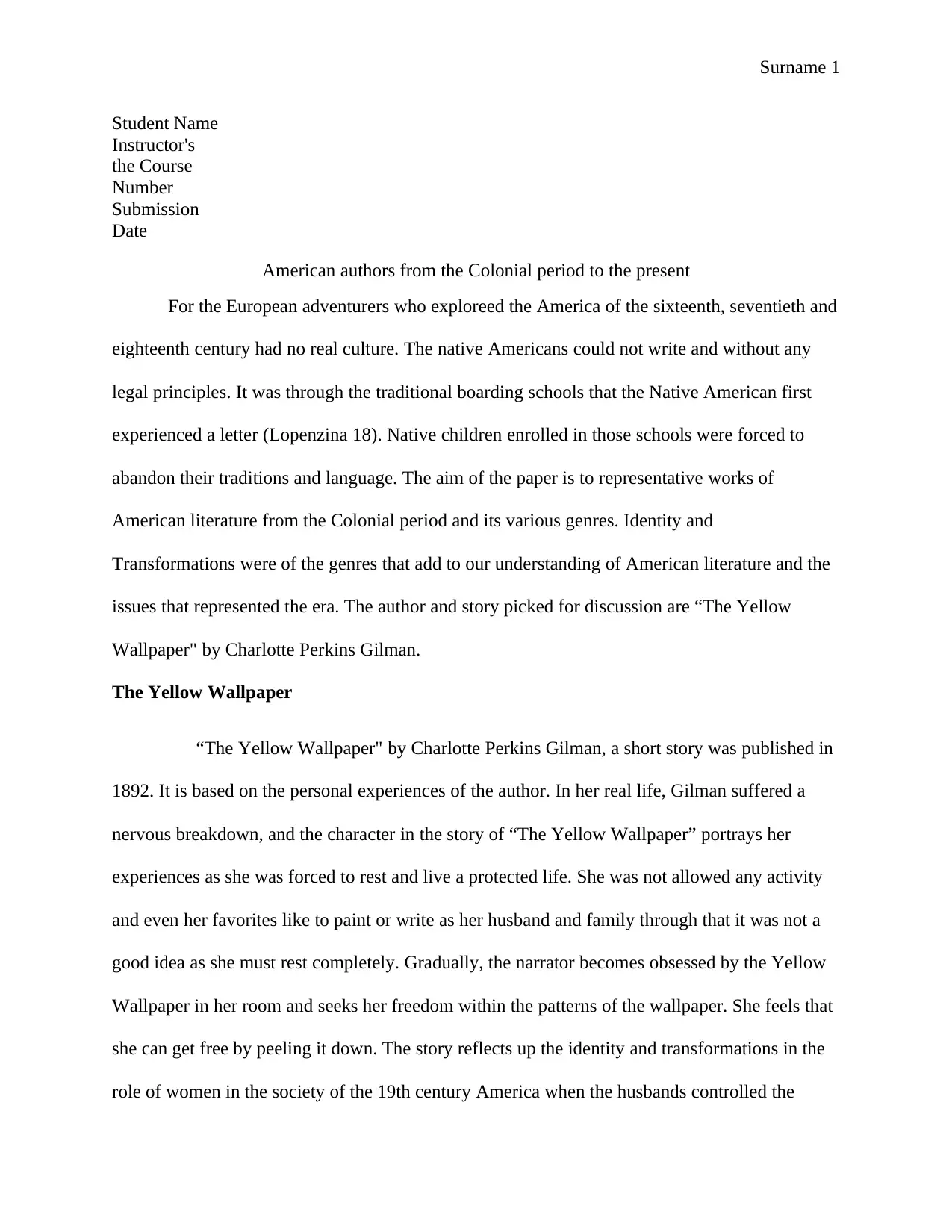
Surname 1
Student Name
Instructor's
the Course
Number
Submission
Date
American authors from the Colonial period to the present
For the European adventurers who exploreed the America of the sixteenth, seventieth and
eighteenth century had no real culture. The native Americans could not write and without any
legal principles. It was through the traditional boarding schools that the Native American first
experienced a letter (Lopenzina 18). Native children enrolled in those schools were forced to
abandon their traditions and language. The aim of the paper is to representative works of
American literature from the Colonial period and its various genres. Identity and
Transformations were of the genres that add to our understanding of American literature and the
issues that represented the era. The author and story picked for discussion are “The Yellow
Wallpaper" by Charlotte Perkins Gilman.
The Yellow Wallpaper
“The Yellow Wallpaper" by Charlotte Perkins Gilman, a short story was published in
1892. It is based on the personal experiences of the author. In her real life, Gilman suffered a
nervous breakdown, and the character in the story of “The Yellow Wallpaper” portrays her
experiences as she was forced to rest and live a protected life. She was not allowed any activity
and even her favorites like to paint or write as her husband and family through that it was not a
good idea as she must rest completely. Gradually, the narrator becomes obsessed by the Yellow
Wallpaper in her room and seeks her freedom within the patterns of the wallpaper. She feels that
she can get free by peeling it down. The story reflects up the identity and transformations in the
role of women in the society of the 19th century America when the husbands controlled the
Student Name
Instructor's
the Course
Number
Submission
Date
American authors from the Colonial period to the present
For the European adventurers who exploreed the America of the sixteenth, seventieth and
eighteenth century had no real culture. The native Americans could not write and without any
legal principles. It was through the traditional boarding schools that the Native American first
experienced a letter (Lopenzina 18). Native children enrolled in those schools were forced to
abandon their traditions and language. The aim of the paper is to representative works of
American literature from the Colonial period and its various genres. Identity and
Transformations were of the genres that add to our understanding of American literature and the
issues that represented the era. The author and story picked for discussion are “The Yellow
Wallpaper" by Charlotte Perkins Gilman.
The Yellow Wallpaper
“The Yellow Wallpaper" by Charlotte Perkins Gilman, a short story was published in
1892. It is based on the personal experiences of the author. In her real life, Gilman suffered a
nervous breakdown, and the character in the story of “The Yellow Wallpaper” portrays her
experiences as she was forced to rest and live a protected life. She was not allowed any activity
and even her favorites like to paint or write as her husband and family through that it was not a
good idea as she must rest completely. Gradually, the narrator becomes obsessed by the Yellow
Wallpaper in her room and seeks her freedom within the patterns of the wallpaper. She feels that
she can get free by peeling it down. The story reflects up the identity and transformations in the
role of women in the society of the 19th century America when the husbands controlled the
Paraphrase This Document
Need a fresh take? Get an instant paraphrase of this document with our AI Paraphraser
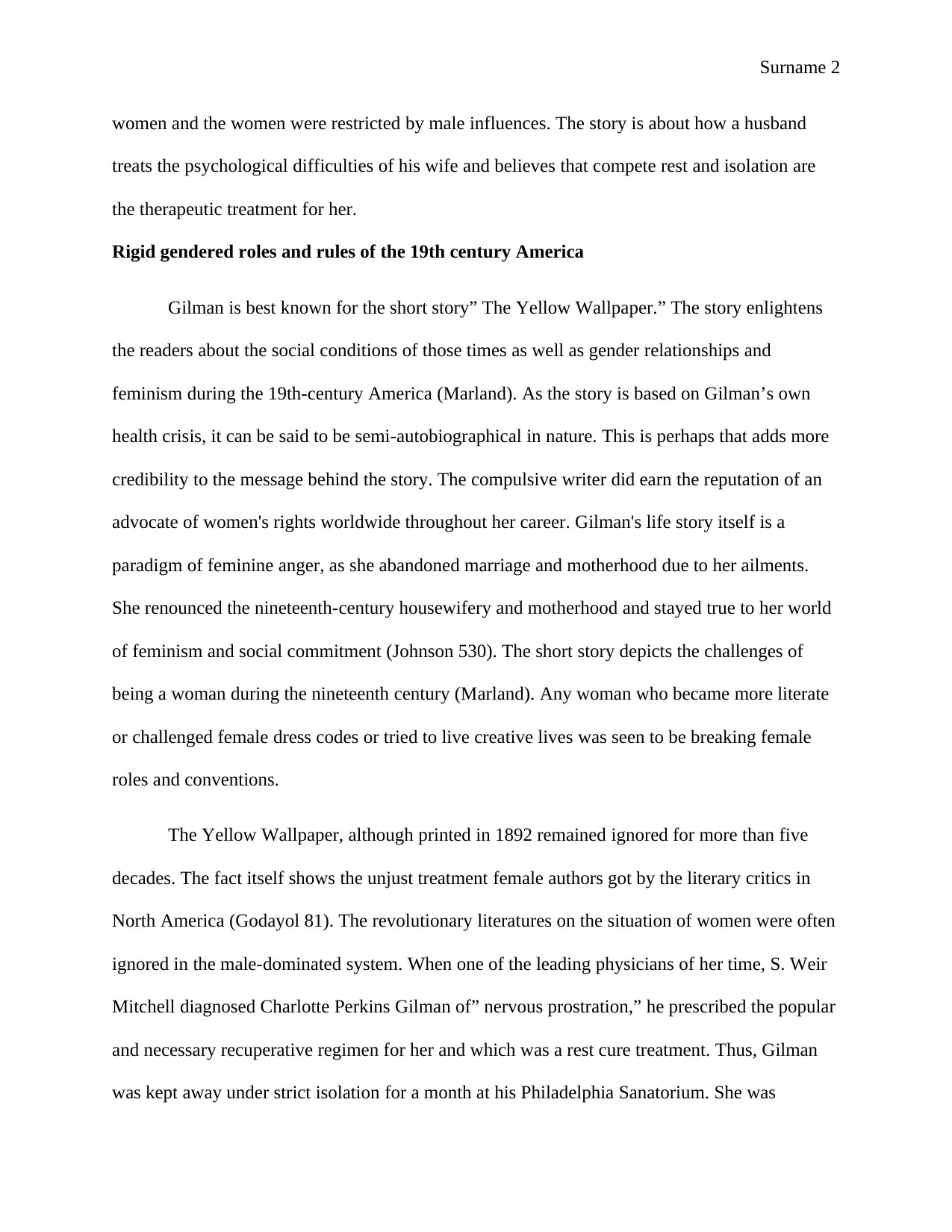
Surname 2
women and the women were restricted by male influences. The story is about how a husband
treats the psychological difficulties of his wife and believes that compete rest and isolation are
the therapeutic treatment for her.
Rigid gendered roles and rules of the 19th century America
Gilman is best known for the short story” The Yellow Wallpaper.” The story enlightens
the readers about the social conditions of those times as well as gender relationships and
feminism during the 19th-century America (Marland). As the story is based on Gilman’s own
health crisis, it can be said to be semi-autobiographical in nature. This is perhaps that adds more
credibility to the message behind the story. The compulsive writer did earn the reputation of an
advocate of women's rights worldwide throughout her career. Gilman's life story itself is a
paradigm of feminine anger, as she abandoned marriage and motherhood due to her ailments.
She renounced the nineteenth-century housewifery and motherhood and stayed true to her world
of feminism and social commitment (Johnson 530). The short story depicts the challenges of
being a woman during the nineteenth century (Marland). Any woman who became more literate
or challenged female dress codes or tried to live creative lives was seen to be breaking female
roles and conventions.
The Yellow Wallpaper, although printed in 1892 remained ignored for more than five
decades. The fact itself shows the unjust treatment female authors got by the literary critics in
North America (Godayol 81). The revolutionary literatures on the situation of women were often
ignored in the male-dominated system. When one of the leading physicians of her time, S. Weir
Mitchell diagnosed Charlotte Perkins Gilman of” nervous prostration,” he prescribed the popular
and necessary recuperative regimen for her and which was a rest cure treatment. Thus, Gilman
was kept away under strict isolation for a month at his Philadelphia Sanatorium. She was
women and the women were restricted by male influences. The story is about how a husband
treats the psychological difficulties of his wife and believes that compete rest and isolation are
the therapeutic treatment for her.
Rigid gendered roles and rules of the 19th century America
Gilman is best known for the short story” The Yellow Wallpaper.” The story enlightens
the readers about the social conditions of those times as well as gender relationships and
feminism during the 19th-century America (Marland). As the story is based on Gilman’s own
health crisis, it can be said to be semi-autobiographical in nature. This is perhaps that adds more
credibility to the message behind the story. The compulsive writer did earn the reputation of an
advocate of women's rights worldwide throughout her career. Gilman's life story itself is a
paradigm of feminine anger, as she abandoned marriage and motherhood due to her ailments.
She renounced the nineteenth-century housewifery and motherhood and stayed true to her world
of feminism and social commitment (Johnson 530). The short story depicts the challenges of
being a woman during the nineteenth century (Marland). Any woman who became more literate
or challenged female dress codes or tried to live creative lives was seen to be breaking female
roles and conventions.
The Yellow Wallpaper, although printed in 1892 remained ignored for more than five
decades. The fact itself shows the unjust treatment female authors got by the literary critics in
North America (Godayol 81). The revolutionary literatures on the situation of women were often
ignored in the male-dominated system. When one of the leading physicians of her time, S. Weir
Mitchell diagnosed Charlotte Perkins Gilman of” nervous prostration,” he prescribed the popular
and necessary recuperative regimen for her and which was a rest cure treatment. Thus, Gilman
was kept away under strict isolation for a month at his Philadelphia Sanatorium. She was
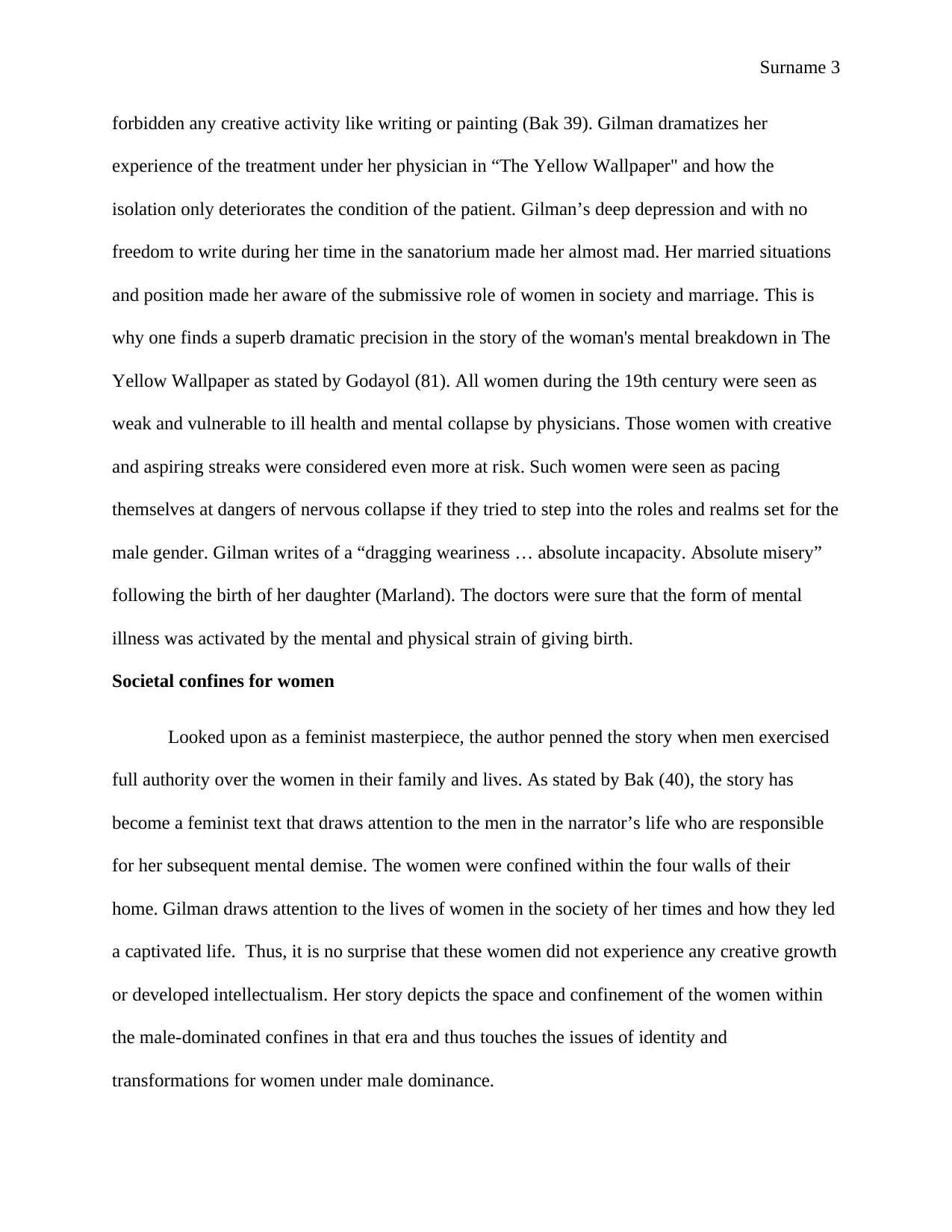
Surname 3
forbidden any creative activity like writing or painting (Bak 39). Gilman dramatizes her
experience of the treatment under her physician in “The Yellow Wallpaper" and how the
isolation only deteriorates the condition of the patient. Gilman’s deep depression and with no
freedom to write during her time in the sanatorium made her almost mad. Her married situations
and position made her aware of the submissive role of women in society and marriage. This is
why one finds a superb dramatic precision in the story of the woman's mental breakdown in The
Yellow Wallpaper as stated by Godayol (81). All women during the 19th century were seen as
weak and vulnerable to ill health and mental collapse by physicians. Those women with creative
and aspiring streaks were considered even more at risk. Such women were seen as pacing
themselves at dangers of nervous collapse if they tried to step into the roles and realms set for the
male gender. Gilman writes of a “dragging weariness … absolute incapacity. Absolute misery”
following the birth of her daughter (Marland). The doctors were sure that the form of mental
illness was activated by the mental and physical strain of giving birth.
Societal confines for women
Looked upon as a feminist masterpiece, the author penned the story when men exercised
full authority over the women in their family and lives. As stated by Bak (40), the story has
become a feminist text that draws attention to the men in the narrator’s life who are responsible
for her subsequent mental demise. The women were confined within the four walls of their
home. Gilman draws attention to the lives of women in the society of her times and how they led
a captivated life. Thus, it is no surprise that these women did not experience any creative growth
or developed intellectualism. Her story depicts the space and confinement of the women within
the male-dominated confines in that era and thus touches the issues of identity and
transformations for women under male dominance.
forbidden any creative activity like writing or painting (Bak 39). Gilman dramatizes her
experience of the treatment under her physician in “The Yellow Wallpaper" and how the
isolation only deteriorates the condition of the patient. Gilman’s deep depression and with no
freedom to write during her time in the sanatorium made her almost mad. Her married situations
and position made her aware of the submissive role of women in society and marriage. This is
why one finds a superb dramatic precision in the story of the woman's mental breakdown in The
Yellow Wallpaper as stated by Godayol (81). All women during the 19th century were seen as
weak and vulnerable to ill health and mental collapse by physicians. Those women with creative
and aspiring streaks were considered even more at risk. Such women were seen as pacing
themselves at dangers of nervous collapse if they tried to step into the roles and realms set for the
male gender. Gilman writes of a “dragging weariness … absolute incapacity. Absolute misery”
following the birth of her daughter (Marland). The doctors were sure that the form of mental
illness was activated by the mental and physical strain of giving birth.
Societal confines for women
Looked upon as a feminist masterpiece, the author penned the story when men exercised
full authority over the women in their family and lives. As stated by Bak (40), the story has
become a feminist text that draws attention to the men in the narrator’s life who are responsible
for her subsequent mental demise. The women were confined within the four walls of their
home. Gilman draws attention to the lives of women in the society of her times and how they led
a captivated life. Thus, it is no surprise that these women did not experience any creative growth
or developed intellectualism. Her story depicts the space and confinement of the women within
the male-dominated confines in that era and thus touches the issues of identity and
transformations for women under male dominance.
⊘ This is a preview!⊘
Do you want full access?
Subscribe today to unlock all pages.

Trusted by 1+ million students worldwide
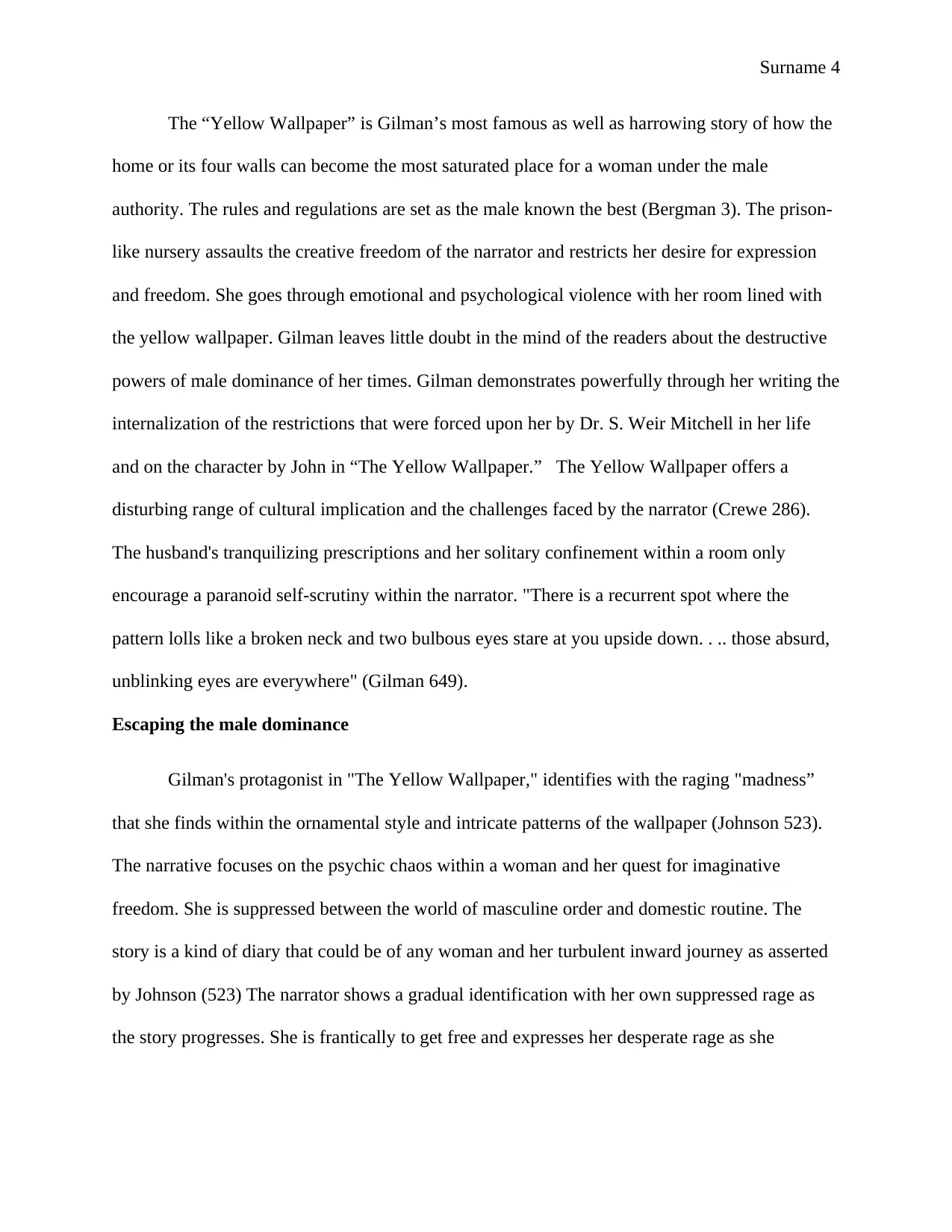
Surname 4
The “Yellow Wallpaper” is Gilman’s most famous as well as harrowing story of how the
home or its four walls can become the most saturated place for a woman under the male
authority. The rules and regulations are set as the male known the best (Bergman 3). The prison-
like nursery assaults the creative freedom of the narrator and restricts her desire for expression
and freedom. She goes through emotional and psychological violence with her room lined with
the yellow wallpaper. Gilman leaves little doubt in the mind of the readers about the destructive
powers of male dominance of her times. Gilman demonstrates powerfully through her writing the
internalization of the restrictions that were forced upon her by Dr. S. Weir Mitchell in her life
and on the character by John in “The Yellow Wallpaper.” The Yellow Wallpaper offers a
disturbing range of cultural implication and the challenges faced by the narrator (Crewe 286).
The husband's tranquilizing prescriptions and her solitary confinement within a room only
encourage a paranoid self-scrutiny within the narrator. "There is a recurrent spot where the
pattern lolls like a broken neck and two bulbous eyes stare at you upside down. . .. those absurd,
unblinking eyes are everywhere" (Gilman 649).
Escaping the male dominance
Gilman's protagonist in "The Yellow Wallpaper," identifies with the raging "madness”
that she finds within the ornamental style and intricate patterns of the wallpaper (Johnson 523).
The narrative focuses on the psychic chaos within a woman and her quest for imaginative
freedom. She is suppressed between the world of masculine order and domestic routine. The
story is a kind of diary that could be of any woman and her turbulent inward journey as asserted
by Johnson (523) The narrator shows a gradual identification with her own suppressed rage as
the story progresses. She is frantically to get free and expresses her desperate rage as she
The “Yellow Wallpaper” is Gilman’s most famous as well as harrowing story of how the
home or its four walls can become the most saturated place for a woman under the male
authority. The rules and regulations are set as the male known the best (Bergman 3). The prison-
like nursery assaults the creative freedom of the narrator and restricts her desire for expression
and freedom. She goes through emotional and psychological violence with her room lined with
the yellow wallpaper. Gilman leaves little doubt in the mind of the readers about the destructive
powers of male dominance of her times. Gilman demonstrates powerfully through her writing the
internalization of the restrictions that were forced upon her by Dr. S. Weir Mitchell in her life
and on the character by John in “The Yellow Wallpaper.” The Yellow Wallpaper offers a
disturbing range of cultural implication and the challenges faced by the narrator (Crewe 286).
The husband's tranquilizing prescriptions and her solitary confinement within a room only
encourage a paranoid self-scrutiny within the narrator. "There is a recurrent spot where the
pattern lolls like a broken neck and two bulbous eyes stare at you upside down. . .. those absurd,
unblinking eyes are everywhere" (Gilman 649).
Escaping the male dominance
Gilman's protagonist in "The Yellow Wallpaper," identifies with the raging "madness”
that she finds within the ornamental style and intricate patterns of the wallpaper (Johnson 523).
The narrative focuses on the psychic chaos within a woman and her quest for imaginative
freedom. She is suppressed between the world of masculine order and domestic routine. The
story is a kind of diary that could be of any woman and her turbulent inward journey as asserted
by Johnson (523) The narrator shows a gradual identification with her own suppressed rage as
the story progresses. She is frantically to get free and expresses her desperate rage as she
Paraphrase This Document
Need a fresh take? Get an instant paraphrase of this document with our AI Paraphraser
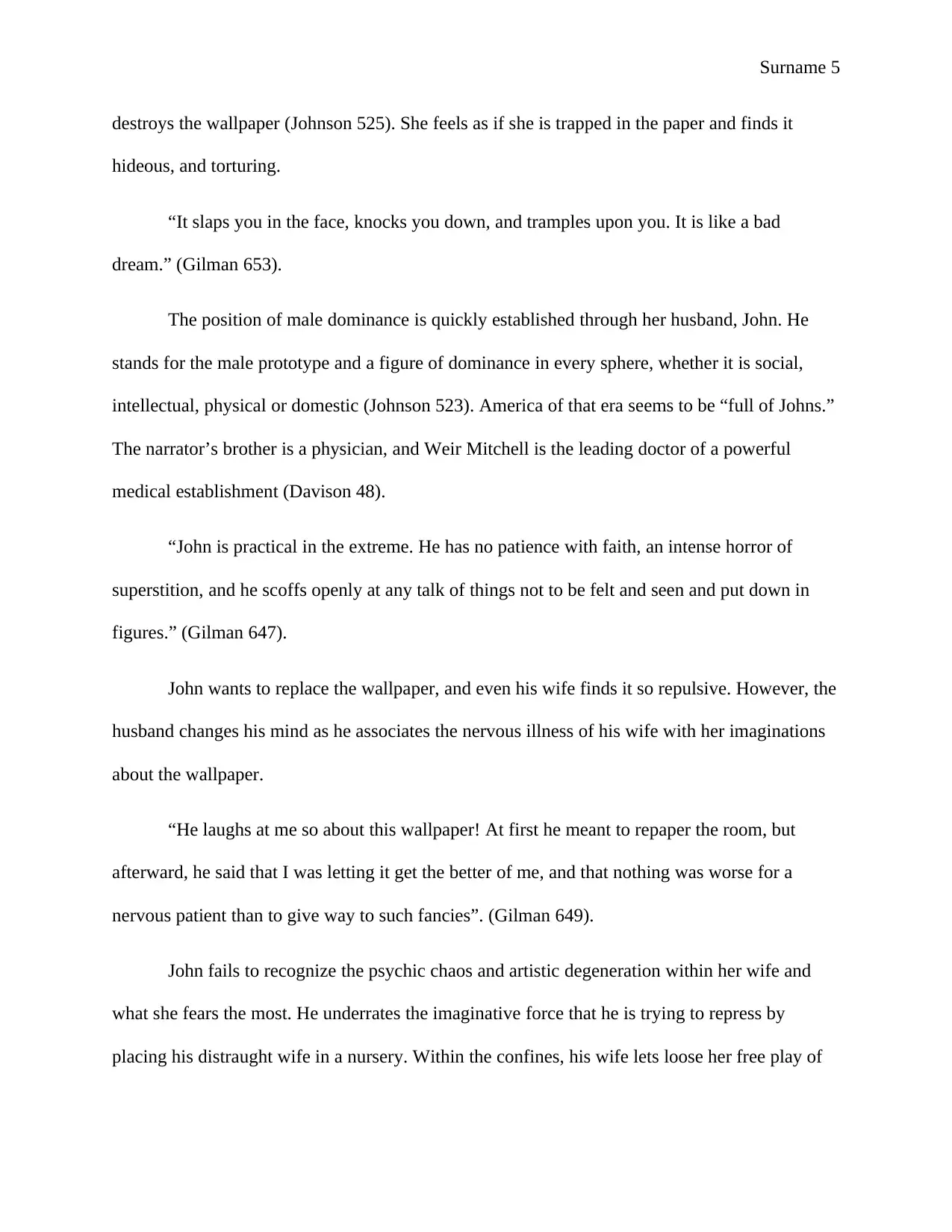
Surname 5
destroys the wallpaper (Johnson 525). She feels as if she is trapped in the paper and finds it
hideous, and torturing.
“It slaps you in the face, knocks you down, and tramples upon you. It is like a bad
dream.” (Gilman 653).
The position of male dominance is quickly established through her husband, John. He
stands for the male prototype and a figure of dominance in every sphere, whether it is social,
intellectual, physical or domestic (Johnson 523). America of that era seems to be “full of Johns.”
The narrator’s brother is a physician, and Weir Mitchell is the leading doctor of a powerful
medical establishment (Davison 48).
“John is practical in the extreme. He has no patience with faith, an intense horror of
superstition, and he scoffs openly at any talk of things not to be felt and seen and put down in
figures.” (Gilman 647).
John wants to replace the wallpaper, and even his wife finds it so repulsive. However, the
husband changes his mind as he associates the nervous illness of his wife with her imaginations
about the wallpaper.
“He laughs at me so about this wallpaper! At first he meant to repaper the room, but
afterward, he said that I was letting it get the better of me, and that nothing was worse for a
nervous patient than to give way to such fancies”. (Gilman 649).
John fails to recognize the psychic chaos and artistic degeneration within her wife and
what she fears the most. He underrates the imaginative force that he is trying to repress by
placing his distraught wife in a nursery. Within the confines, his wife lets loose her free play of
destroys the wallpaper (Johnson 525). She feels as if she is trapped in the paper and finds it
hideous, and torturing.
“It slaps you in the face, knocks you down, and tramples upon you. It is like a bad
dream.” (Gilman 653).
The position of male dominance is quickly established through her husband, John. He
stands for the male prototype and a figure of dominance in every sphere, whether it is social,
intellectual, physical or domestic (Johnson 523). America of that era seems to be “full of Johns.”
The narrator’s brother is a physician, and Weir Mitchell is the leading doctor of a powerful
medical establishment (Davison 48).
“John is practical in the extreme. He has no patience with faith, an intense horror of
superstition, and he scoffs openly at any talk of things not to be felt and seen and put down in
figures.” (Gilman 647).
John wants to replace the wallpaper, and even his wife finds it so repulsive. However, the
husband changes his mind as he associates the nervous illness of his wife with her imaginations
about the wallpaper.
“He laughs at me so about this wallpaper! At first he meant to repaper the room, but
afterward, he said that I was letting it get the better of me, and that nothing was worse for a
nervous patient than to give way to such fancies”. (Gilman 649).
John fails to recognize the psychic chaos and artistic degeneration within her wife and
what she fears the most. He underrates the imaginative force that he is trying to repress by
placing his distraught wife in a nursery. Within the confines, his wife lets loose her free play of
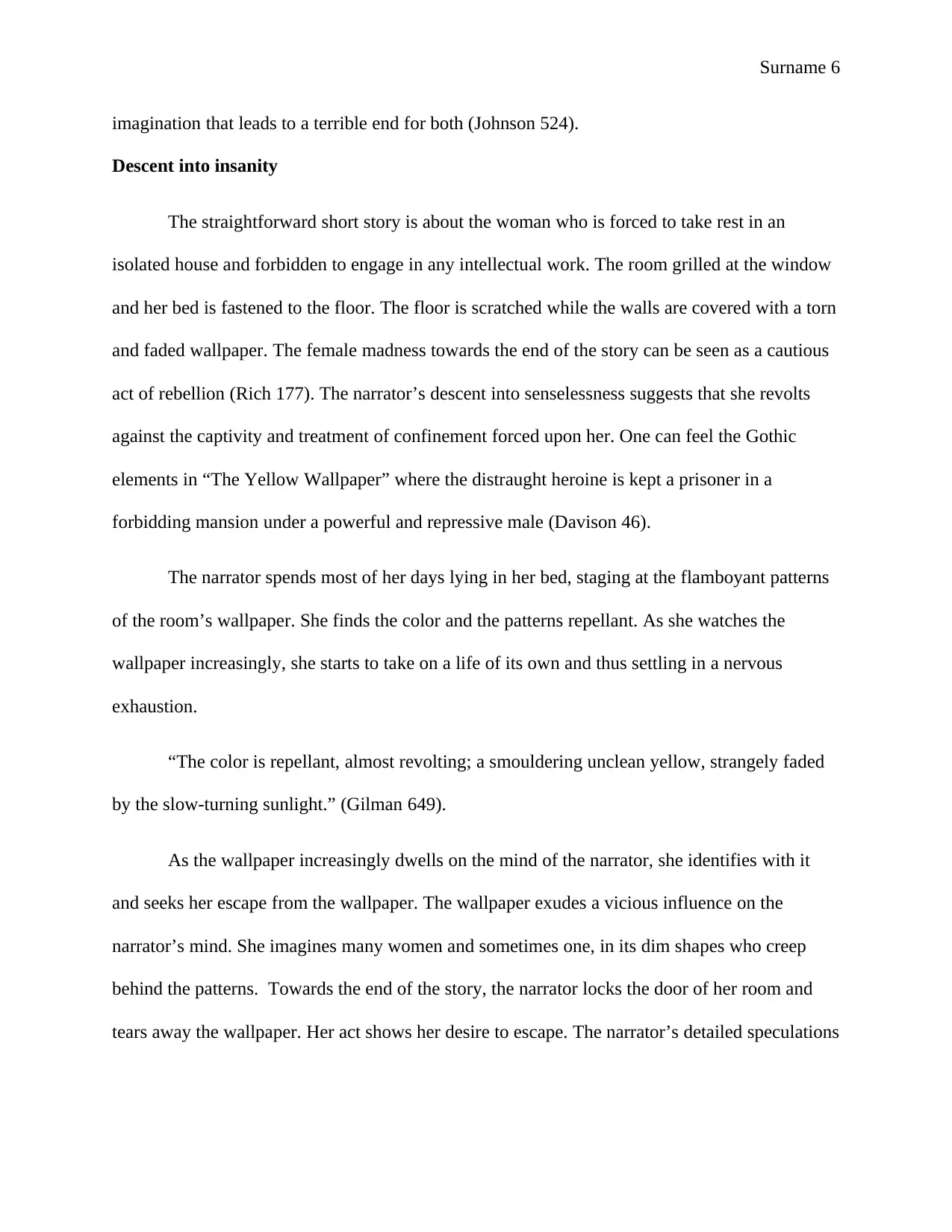
Surname 6
imagination that leads to a terrible end for both (Johnson 524).
Descent into insanity
The straightforward short story is about the woman who is forced to take rest in an
isolated house and forbidden to engage in any intellectual work. The room grilled at the window
and her bed is fastened to the floor. The floor is scratched while the walls are covered with a torn
and faded wallpaper. The female madness towards the end of the story can be seen as a cautious
act of rebellion (Rich 177). The narrator’s descent into senselessness suggests that she revolts
against the captivity and treatment of confinement forced upon her. One can feel the Gothic
elements in “The Yellow Wallpaper” where the distraught heroine is kept a prisoner in a
forbidding mansion under a powerful and repressive male (Davison 46).
The narrator spends most of her days lying in her bed, staging at the flamboyant patterns
of the room’s wallpaper. She finds the color and the patterns repellant. As she watches the
wallpaper increasingly, she starts to take on a life of its own and thus settling in a nervous
exhaustion.
“The color is repellant, almost revolting; a smouldering unclean yellow, strangely faded
by the slow-turning sunlight.” (Gilman 649).
As the wallpaper increasingly dwells on the mind of the narrator, she identifies with it
and seeks her escape from the wallpaper. The wallpaper exudes a vicious influence on the
narrator’s mind. She imagines many women and sometimes one, in its dim shapes who creep
behind the patterns. Towards the end of the story, the narrator locks the door of her room and
tears away the wallpaper. Her act shows her desire to escape. The narrator’s detailed speculations
imagination that leads to a terrible end for both (Johnson 524).
Descent into insanity
The straightforward short story is about the woman who is forced to take rest in an
isolated house and forbidden to engage in any intellectual work. The room grilled at the window
and her bed is fastened to the floor. The floor is scratched while the walls are covered with a torn
and faded wallpaper. The female madness towards the end of the story can be seen as a cautious
act of rebellion (Rich 177). The narrator’s descent into senselessness suggests that she revolts
against the captivity and treatment of confinement forced upon her. One can feel the Gothic
elements in “The Yellow Wallpaper” where the distraught heroine is kept a prisoner in a
forbidding mansion under a powerful and repressive male (Davison 46).
The narrator spends most of her days lying in her bed, staging at the flamboyant patterns
of the room’s wallpaper. She finds the color and the patterns repellant. As she watches the
wallpaper increasingly, she starts to take on a life of its own and thus settling in a nervous
exhaustion.
“The color is repellant, almost revolting; a smouldering unclean yellow, strangely faded
by the slow-turning sunlight.” (Gilman 649).
As the wallpaper increasingly dwells on the mind of the narrator, she identifies with it
and seeks her escape from the wallpaper. The wallpaper exudes a vicious influence on the
narrator’s mind. She imagines many women and sometimes one, in its dim shapes who creep
behind the patterns. Towards the end of the story, the narrator locks the door of her room and
tears away the wallpaper. Her act shows her desire to escape. The narrator’s detailed speculations
⊘ This is a preview!⊘
Do you want full access?
Subscribe today to unlock all pages.

Trusted by 1+ million students worldwide
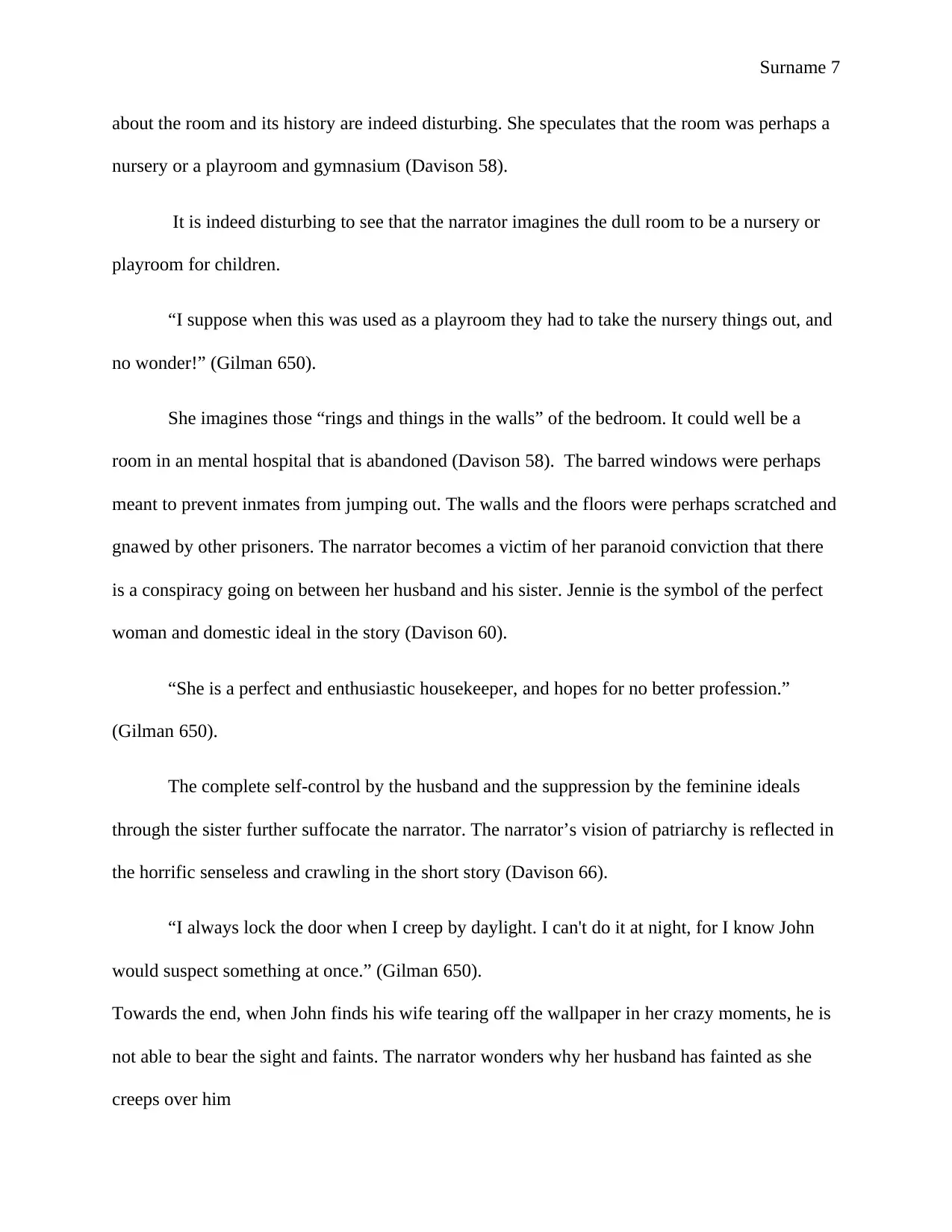
Surname 7
about the room and its history are indeed disturbing. She speculates that the room was perhaps a
nursery or a playroom and gymnasium (Davison 58).
It is indeed disturbing to see that the narrator imagines the dull room to be a nursery or
playroom for children.
“I suppose when this was used as a playroom they had to take the nursery things out, and
no wonder!” (Gilman 650).
She imagines those “rings and things in the walls” of the bedroom. It could well be a
room in an mental hospital that is abandoned (Davison 58). The barred windows were perhaps
meant to prevent inmates from jumping out. The walls and the floors were perhaps scratched and
gnawed by other prisoners. The narrator becomes a victim of her paranoid conviction that there
is a conspiracy going on between her husband and his sister. Jennie is the symbol of the perfect
woman and domestic ideal in the story (Davison 60).
“She is a perfect and enthusiastic housekeeper, and hopes for no better profession.”
(Gilman 650).
The complete self-control by the husband and the suppression by the feminine ideals
through the sister further suffocate the narrator. The narrator’s vision of patriarchy is reflected in
the horrific senseless and crawling in the short story (Davison 66).
“I always lock the door when I creep by daylight. I can't do it at night, for I know John
would suspect something at once.” (Gilman 650).
Towards the end, when John finds his wife tearing off the wallpaper in her crazy moments, he is
not able to bear the sight and faints. The narrator wonders why her husband has fainted as she
creeps over him
about the room and its history are indeed disturbing. She speculates that the room was perhaps a
nursery or a playroom and gymnasium (Davison 58).
It is indeed disturbing to see that the narrator imagines the dull room to be a nursery or
playroom for children.
“I suppose when this was used as a playroom they had to take the nursery things out, and
no wonder!” (Gilman 650).
She imagines those “rings and things in the walls” of the bedroom. It could well be a
room in an mental hospital that is abandoned (Davison 58). The barred windows were perhaps
meant to prevent inmates from jumping out. The walls and the floors were perhaps scratched and
gnawed by other prisoners. The narrator becomes a victim of her paranoid conviction that there
is a conspiracy going on between her husband and his sister. Jennie is the symbol of the perfect
woman and domestic ideal in the story (Davison 60).
“She is a perfect and enthusiastic housekeeper, and hopes for no better profession.”
(Gilman 650).
The complete self-control by the husband and the suppression by the feminine ideals
through the sister further suffocate the narrator. The narrator’s vision of patriarchy is reflected in
the horrific senseless and crawling in the short story (Davison 66).
“I always lock the door when I creep by daylight. I can't do it at night, for I know John
would suspect something at once.” (Gilman 650).
Towards the end, when John finds his wife tearing off the wallpaper in her crazy moments, he is
not able to bear the sight and faints. The narrator wonders why her husband has fainted as she
creeps over him
Paraphrase This Document
Need a fresh take? Get an instant paraphrase of this document with our AI Paraphraser
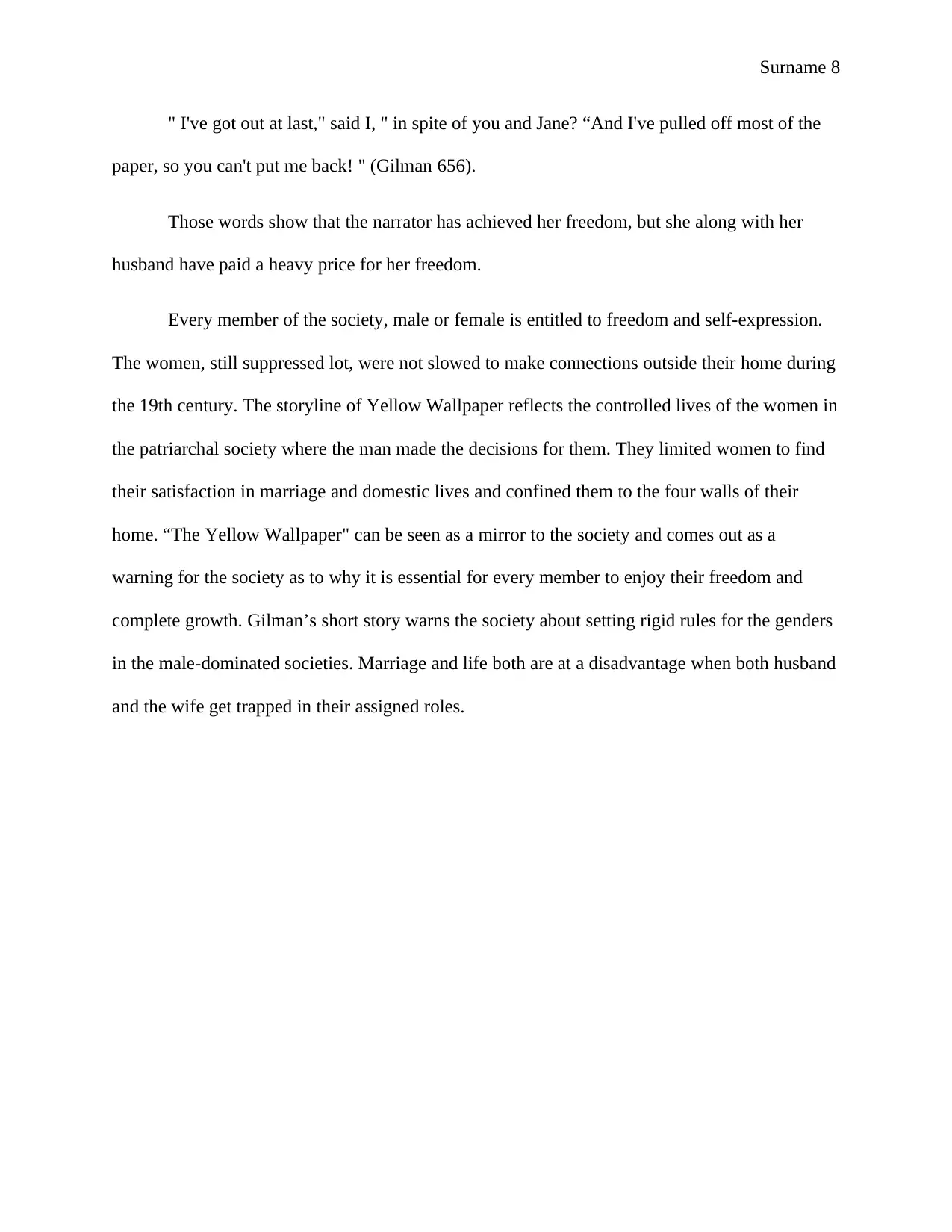
Surname 8
" I've got out at last," said I, " in spite of you and Jane? “And I've pulled off most of the
paper, so you can't put me back! " (Gilman 656).
Those words show that the narrator has achieved her freedom, but she along with her
husband have paid a heavy price for her freedom.
Every member of the society, male or female is entitled to freedom and self-expression.
The women, still suppressed lot, were not slowed to make connections outside their home during
the 19th century. The storyline of Yellow Wallpaper reflects the controlled lives of the women in
the patriarchal society where the man made the decisions for them. They limited women to find
their satisfaction in marriage and domestic lives and confined them to the four walls of their
home. “The Yellow Wallpaper" can be seen as a mirror to the society and comes out as a
warning for the society as to why it is essential for every member to enjoy their freedom and
complete growth. Gilman’s short story warns the society about setting rigid rules for the genders
in the male-dominated societies. Marriage and life both are at a disadvantage when both husband
and the wife get trapped in their assigned roles.
" I've got out at last," said I, " in spite of you and Jane? “And I've pulled off most of the
paper, so you can't put me back! " (Gilman 656).
Those words show that the narrator has achieved her freedom, but she along with her
husband have paid a heavy price for her freedom.
Every member of the society, male or female is entitled to freedom and self-expression.
The women, still suppressed lot, were not slowed to make connections outside their home during
the 19th century. The storyline of Yellow Wallpaper reflects the controlled lives of the women in
the patriarchal society where the man made the decisions for them. They limited women to find
their satisfaction in marriage and domestic lives and confined them to the four walls of their
home. “The Yellow Wallpaper" can be seen as a mirror to the society and comes out as a
warning for the society as to why it is essential for every member to enjoy their freedom and
complete growth. Gilman’s short story warns the society about setting rigid rules for the genders
in the male-dominated societies. Marriage and life both are at a disadvantage when both husband
and the wife get trapped in their assigned roles.
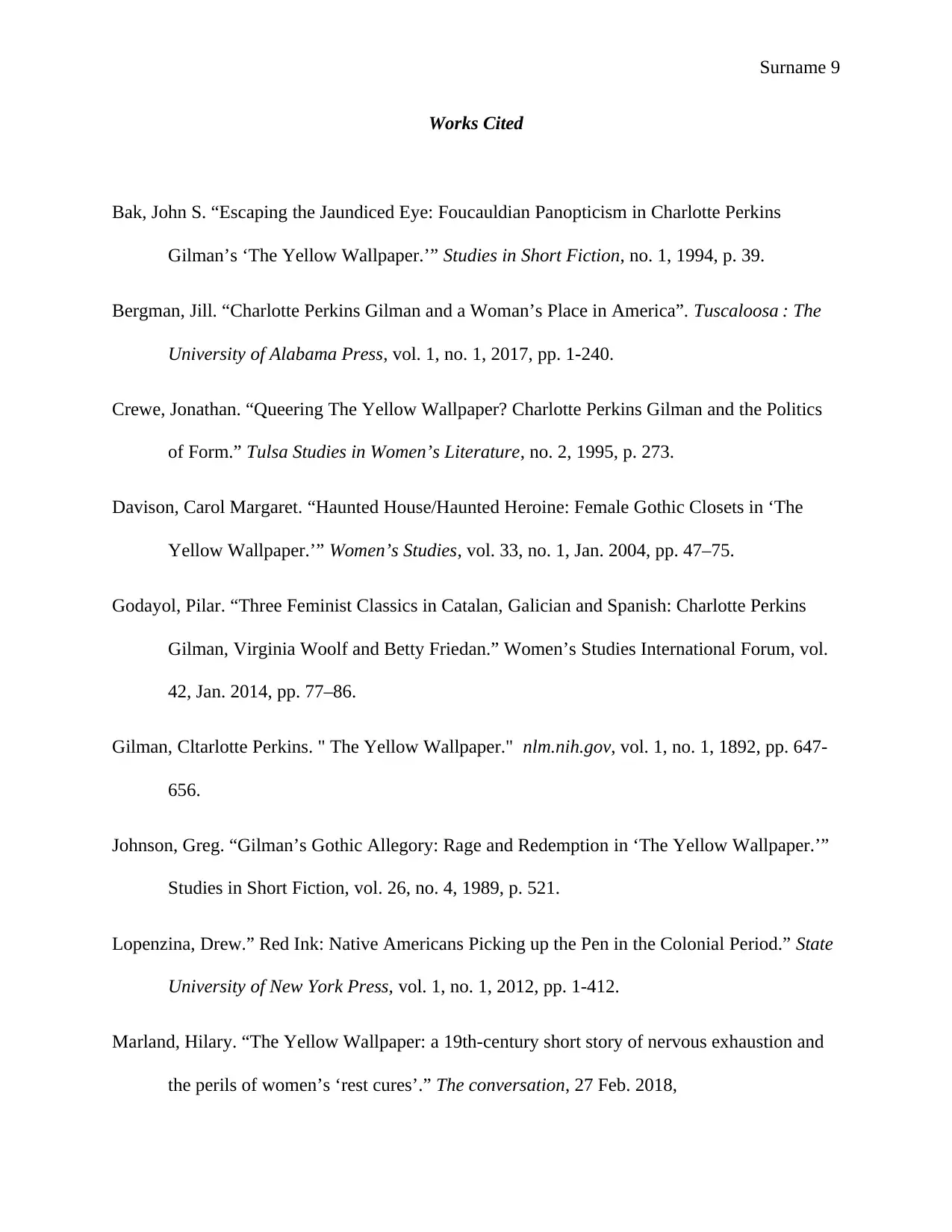
Surname 9
Works Cited
Bak, John S. “Escaping the Jaundiced Eye: Foucauldian Panopticism in Charlotte Perkins
Gilman’s ‘The Yellow Wallpaper.’” Studies in Short Fiction, no. 1, 1994, p. 39.
Bergman, Jill. “Charlotte Perkins Gilman and a Woman’s Place in America”. Tuscaloosa : The
University of Alabama Press, vol. 1, no. 1, 2017, pp. 1-240.
Crewe, Jonathan. “Queering The Yellow Wallpaper? Charlotte Perkins Gilman and the Politics
of Form.” Tulsa Studies in Women’s Literature, no. 2, 1995, p. 273.
Davison, Carol Margaret. “Haunted House/Haunted Heroine: Female Gothic Closets in ‘The
Yellow Wallpaper.’” Women’s Studies, vol. 33, no. 1, Jan. 2004, pp. 47–75.
Godayol, Pilar. “Three Feminist Classics in Catalan, Galician and Spanish: Charlotte Perkins
Gilman, Virginia Woolf and Betty Friedan.” Women’s Studies International Forum, vol.
42, Jan. 2014, pp. 77–86.
Gilman, Cltarlotte Perkins. " The Yellow Wallpaper." nlm.nih.gov, vol. 1, no. 1, 1892, pp. 647-
656.
Johnson, Greg. “Gilman’s Gothic Allegory: Rage and Redemption in ‘The Yellow Wallpaper.’”
Studies in Short Fiction, vol. 26, no. 4, 1989, p. 521.
Lopenzina, Drew.” Red Ink: Native Americans Picking up the Pen in the Colonial Period.” State
University of New York Press, vol. 1, no. 1, 2012, pp. 1-412.
Marland, Hilary. “The Yellow Wallpaper: a 19th-century short story of nervous exhaustion and
the perils of women’s ‘rest cures’.” The conversation, 27 Feb. 2018,
Works Cited
Bak, John S. “Escaping the Jaundiced Eye: Foucauldian Panopticism in Charlotte Perkins
Gilman’s ‘The Yellow Wallpaper.’” Studies in Short Fiction, no. 1, 1994, p. 39.
Bergman, Jill. “Charlotte Perkins Gilman and a Woman’s Place in America”. Tuscaloosa : The
University of Alabama Press, vol. 1, no. 1, 2017, pp. 1-240.
Crewe, Jonathan. “Queering The Yellow Wallpaper? Charlotte Perkins Gilman and the Politics
of Form.” Tulsa Studies in Women’s Literature, no. 2, 1995, p. 273.
Davison, Carol Margaret. “Haunted House/Haunted Heroine: Female Gothic Closets in ‘The
Yellow Wallpaper.’” Women’s Studies, vol. 33, no. 1, Jan. 2004, pp. 47–75.
Godayol, Pilar. “Three Feminist Classics in Catalan, Galician and Spanish: Charlotte Perkins
Gilman, Virginia Woolf and Betty Friedan.” Women’s Studies International Forum, vol.
42, Jan. 2014, pp. 77–86.
Gilman, Cltarlotte Perkins. " The Yellow Wallpaper." nlm.nih.gov, vol. 1, no. 1, 1892, pp. 647-
656.
Johnson, Greg. “Gilman’s Gothic Allegory: Rage and Redemption in ‘The Yellow Wallpaper.’”
Studies in Short Fiction, vol. 26, no. 4, 1989, p. 521.
Lopenzina, Drew.” Red Ink: Native Americans Picking up the Pen in the Colonial Period.” State
University of New York Press, vol. 1, no. 1, 2012, pp. 1-412.
Marland, Hilary. “The Yellow Wallpaper: a 19th-century short story of nervous exhaustion and
the perils of women’s ‘rest cures’.” The conversation, 27 Feb. 2018,
⊘ This is a preview!⊘
Do you want full access?
Subscribe today to unlock all pages.

Trusted by 1+ million students worldwide

Surname 10
theconversation.com/the-yellow-wallpaper-a-19th-century-short-story-of-nervous-
exhaustion-and-the-perils-of-womens-rest-cures-92302. Accessed 11 Nov. 2018
Rich, Charlotte. “‘The Yellow-Wallpaper’ by Charlotte Perkins Gilman: A Dual Text Critical
Edition.” American Literary Realism, no. 2, 2010, p. 176-178.
theconversation.com/the-yellow-wallpaper-a-19th-century-short-story-of-nervous-
exhaustion-and-the-perils-of-womens-rest-cures-92302. Accessed 11 Nov. 2018
Rich, Charlotte. “‘The Yellow-Wallpaper’ by Charlotte Perkins Gilman: A Dual Text Critical
Edition.” American Literary Realism, no. 2, 2010, p. 176-178.
1 out of 10
Related Documents
Your All-in-One AI-Powered Toolkit for Academic Success.
+13062052269
info@desklib.com
Available 24*7 on WhatsApp / Email
![[object Object]](/_next/static/media/star-bottom.7253800d.svg)
Unlock your academic potential
Copyright © 2020–2025 A2Z Services. All Rights Reserved. Developed and managed by ZUCOL.





